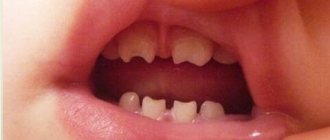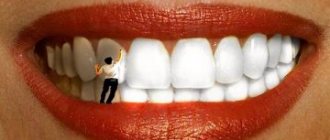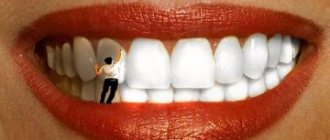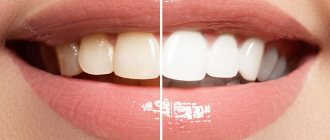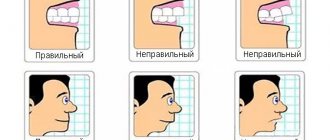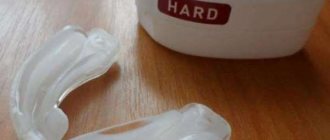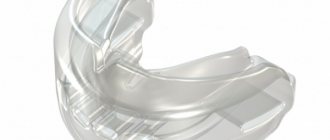What is retention
Retention is a delay in the growth of baby or molar teeth. With this pathology, the tooth may erupt, but not completely, but can be barely visible above the gum, and it can also grow only under the gum, not showing out at all. First of all, this disease affects the second premolars and third molars located on the lower jaw, as well as the canines of the upper jaw. Maxillary canine impaction is much more common in women. This pathology can occur on one side of the jaw or on both sides at once. Canine impaction in the lower jaw is a very rare occurrence. Impaction of primary teeth is also extremely rare. Such disorders in children can be caused by an acute lack of vitamins in the body or serious pathologies during teething. Impaction of primary teeth can be caused by severe rickets.
Why is it dangerous
Taking into account the number, location, size of the jaw and the age of the patient, the negative consequences are:
- delayed eruption of primary teeth;
- the formation of a diastema - a gap between the front incisors;
- damage to the mucous membrane leading to inflammation;
- inability to comply with hygiene measures;
- violation of the chewing process and digestive problems;
- the impossibility of proper oral hygiene and, as a consequence, the spread of carious bacteria.
Types of pathology
Teeth eruption disorders can be of two types: complete and partial, and the tooth, respectively, impacted and semi-impacted. The last type means that the tooth has erupted a little, i.e. visually observed above the gum. The impacted tooth is completely hidden by the gum and is not accessible to palpation. According to the depth of their occurrence, such teeth can be tissue embedded (the tooth is located in the gum tissue) or bone embedded (lies in the jaw bone). Such teeth can be located:
- Angularly, i.e. at an angle.
- Vertical.
- Horizontally.
Sometimes there are so-called reverse impacted teeth, most often these are the lower eighth teeth. In such teeth, the upper part is turned towards the jaw, and the roots are turned towards the alveolar edge. There are also symmetrical, unilateral or bilateral tooth retention.
Symptoms and diagnosis
This deviation has visual signs, so a good dentist will detect hyperdontia at the first manifestations. Signals that may indicate supernumerary teeth in a child:
- speech defects (lisp, swallowing sounds);
- displacement of the dentition, malocclusion;
- slowing down the appearance of molars;
- malfunction of the gastrointestinal tract;
- rotation of healthy teeth around their axis.
Extra teeth have weak and crooked roots. They grow in an abnormal order, and the shape can be different, mainly in the form of a cone. Size is smaller than that of healthy people. Parents manage to detect hyperdontia when the central incisors erupt. To confirm or refute your guess, visit your dentist.
Family Dentistry will take an x-ray or perform a 3D tomography to determine the location of extra teeth and their exact number.
Why does a canine or molar not appear?
The concept of retention refers to the anatomical specificity of the jaw or an anomaly in the formation of the tooth germ. Experts believe that this pathology arose in modern society as a result of eating too soft food, i.e. people have practically stopped chewing solid food. Other reasons why retention may occur:
- improper feeding of the child;
- reduced immunity associated with exposure to infections;
- delay in replacing milk teeth with molars;
- the presence of supernumerary teeth that prevent the eruption of a permanent tooth;
- incorrect location of the permanent tooth germ in the jaw bone. With this pathology, the crown of the tooth is directed towards the root of the adjacent tooth, thereby preventing its appearance and the eruption of neighboring teeth;
- bad heredity.
Causes of hyperdontia
There is no consensus among experts about the reasons for the appearance of extra teeth. There are several versions:
- hyperdontia is a manifestation of atavism;
- the embryonic plate has split into too many tooth germs;
- genetic and hereditary factor.
It is not possible to prevent hyperdontia, so we recommend that parents pay more attention to the dentist’s findings. Timely measures are a guarantee of successful treatment.
The main symptoms of the pathology
Retention in dentistry is quite common, and there are some signs by which this pathology can be detected:
- pain in the gums, radiating to the ear and temporal part;
- regular injury to the same place in the oral mucosa;
- numbness and swelling;
- painful sensations when opening the mouth and while chewing food;
- mobility or displacement of teeth;
- deterioration of general health due to the inflammatory process (fever, weakness, chills, etc.);
- the appearance of a cyst or abscess.
What can happen if you refuse the help of a specialist?
If the tooth root remains under the layer of gum tissue, decay can spread to neighboring units. In this case, treatment will be longer and more expensive. The main symptoms of this problem are a strong odor from the mouth and periodic pain that radiates to the head. Harmful microorganisms will begin to accumulate under the gums, which can lead to the development of caries.
In 99% of cases, the patient has a small sac with purulent filling at the apex of the root. After some time, it inevitably turns into a painful swelling called gumboil. The only correct solution when gums grow on a tooth is to quickly contact an experienced dentist. It will not only eliminate inflammation, but will also be able to save the destroyed unit.
previous post
What happens if you swallow toothpaste?
next entry
Elimination of anomaly
Treatment of retention is a rather complex process that requires qualified assistance from dentists of several specializations. Treatment is selected individually for each patient and depends on the clinical picture of the oral cavity. The first question that a dentist needs to decide is whether to remove or save a diseased tooth. There are several treatment methods, most often this is a surgical intervention in which a specialist cuts the gingival hood so that nothing prevents the tooth from erupting outward. Surgical procedures of this kind are used in situations where the tooth grows correctly and does not interfere with neighboring teeth. In other cases, most often, the tooth is removed. Removing an impacted tooth is a rather difficult operation. The procedure is carried out under local anesthesia, after which the gum is cut, and the specialist uses a bur to create access to the tooth, after which it is completely removed. Then a special medicine is placed into the tooth socket. If necessary, sutures are applied and removed ten days after the procedure. Swelling may occur after removal of an impacted tooth. Most often, after removing such a tooth, the doctor prescribes antibiotics and painkillers. Also, the patient, for the first few days, needs to stop eating solid foods, hot and cold foods and drinks.
Types of polyodontia disease
Polyodontia in the oral cavity manifests itself in different ways. By studying the statistics, signs and symptoms of the disease, dentists were able to classify the types of this anomaly.
Depending on the origin, the disease is divided into two types:
- False polyodontia. Provides for a baby tooth that does not fall out, regardless of the person’s age. At the same time, it fulfills its functions, does not create discomfort to the bite, and is firmly fixed in the patient’s jaw. In addition, teeth fused together and other anomalies are classified as a false type of disease.
- True polyodontia. It can be caused by genetic predisposition, as well as terogenic factors. At the same time, extra molars begin to form in the human jaw.
Incorrect growth of wisdom teeth
70% of people who turn to the clinic for help with the eruption of a wisdom tooth are diagnosed with its incorrect location. Often the concept implies a horizontal tilt, excessive grinding into the seven, or the growth of the eighth tooth into the root part of the neighboring one.
- The growth of a tooth under the gum harms the rest. The sooner a person shows interest and finds out exactly how even an unerupted wisdom tooth is located in the jaw, the easier it will be to eliminate the problem when it is discovered. It happens that the figure eight harms the healthy seventh tooth, while still hidden under the gum. While growing, the third molar seems to be trying to push out the neighboring one or rests against its walls, causing damage. It is better to remove such a wisdom tooth in advance, otherwise the risk of damage to a healthy molar increases. Later, you will have to get rid of both the third and second molars, which have lost functionality.
- A similar situation develops when a wisdom tooth erupts at an angle. As it continues to grow, it will begin to prop up the seven. A particularly alarming picture emerges if there is a lack of space on the jaw. Then the dentition loses its alignment. More often this problem occurs in women.
- The recumbent position of a wisdom tooth is also considered unfavorable , especially when the tooth is turned towards the adjacent seventh tooth. A person sometimes argues that preserving his own, albeit pathologically growing, tooth may be useful in the future, when the time comes to install a crown on the tooth. And the recumbent tooth takes up a lot of space in the row, shifting the others and causing their uneven arrangement.
- The fit of the figure eight to the second molar , even with an anatomically correct location, is also not considered a good sign. Excessive crowding of teeth in the depths of the oral cavity almost always causes the development of caries.
- At first glance, the direction of the wisdom tooth towards the cheek However, this is an imaginary impression. A tooth growing sideways regularly causes microdamage to the vulnerable mucous membrane of the cheek. Often leads to gum inflammation and pericoronitis. The seriousness of the situation is enhanced by the fact that the mucous membrane of the cheeks is not rich in pain receptors, so a person sometimes does not even feel the harm being caused.
- As a result, the cheek is damaged from the inside, and the wounded area becomes a gateway for infection and becomes severely inflamed. Gradually, the cells of the mucosa, under the pressure of what is happening, are transformed and replaced by foreign, denser tissue. This indicates the emergence of neoplasms at the site of permanent injury - benign or carcinogenic.
Dentists recommend removing wisdom teeth that are positioned incorrectly in advance. This information is available to the patient after undergoing an X-ray examination. The picture immediately shows how the figure eight is located inside the gum; it becomes possible to predict the result when it erupts.
Ultrasonic removal of wisdom teeth using a piezotome
You don’t even need to wait for the mentioned process to begin; the modern level of development of dentistry allows the doctor to intervene while the tooth is “sleeping” and perform an operation to extract it in adolescence. In youth, such manipulation is tolerated much easier, and tissue regeneration occurs faster and more completely. And by the time you turn twenty-five, the undesirable scenario of the eruption of a crooked wisdom tooth will be a thing of the past.
Make an appointment with surgeons at Dr. Lopaeva’s clinic
Make an appointment
Or call +7(985)532-21-01
Types of teething disorders
Teething in children, the sequence of which is clearly defined, can occur with a delay caused by various reasons (illness of the mother during pregnancy, diseases suffered by the child, etc.). Due to the delay, deformation of the jaws may begin, because There is not enough free space for teeth that have not yet erupted. In this case, only the dentist can decide on treatment after a thorough visual examination of the child and analysis of the photograph taken.
The next very common disorder is enamel hypoplasia, which manifests itself in spots of different colors on newly emerging teeth, pits or grooves. Hypoplasia causes complications during pregnancy.
After removal of a recumbent wisdom tooth
While the anesthesia is in effect, the patient does not feel pain. But when the effect of the drug wears off, sensitivity gradually returns, and the person begins to feel pain. This pain is physiological, because the doctor cut the tissue, touched the bone, and the nerve endings were damaged. After a few days, the sensations finally subside. The following symptoms are possible:
- Mild hyperthermia;
- General malaise, weakness;
- Development of edema;
- Bleeding in the socket area.
Sometimes bleeding from the site of tooth extraction frightens a person; this is a natural reaction. The patient always thinks that he has lost more blood than actually happened. Sometimes the phenomenon continues for hours and usually stops completely by the evening. But if the nature of the bleeding remains unchanged throughout the day, the pain increases, and purulent spots appear in the socket, then the discomfort cannot be tolerated. This requires quick response measures to stop the developed inflammatory process.
As for the placement of extra teeth, dentists distinguish the following types of disease:
- Typical hyperdontia. Applies to those patients in whom extra teeth appear only in the dentition and do not extend beyond it. Many scientists are confident that this is simply heredity, because our ancestors had a more developed dental system than modern people.
- Atypical hyperdontia. It occurs much less frequently and is characterized by the appearance of teeth outside the dentition.
In case of anomalies with baby teeth, the latter pose almost no threat. On the contrary, such a tooth can last a lifetime. But the permanent molars, over which the supernumeraries grow, should be removed, if only because it is not aesthetically pleasing.
Often, the patient grows extra fangs or incisors, or even several front teeth at once. In addition to a ruined smile, the disease can cause serious complications if the necessary measures are not taken in time.




